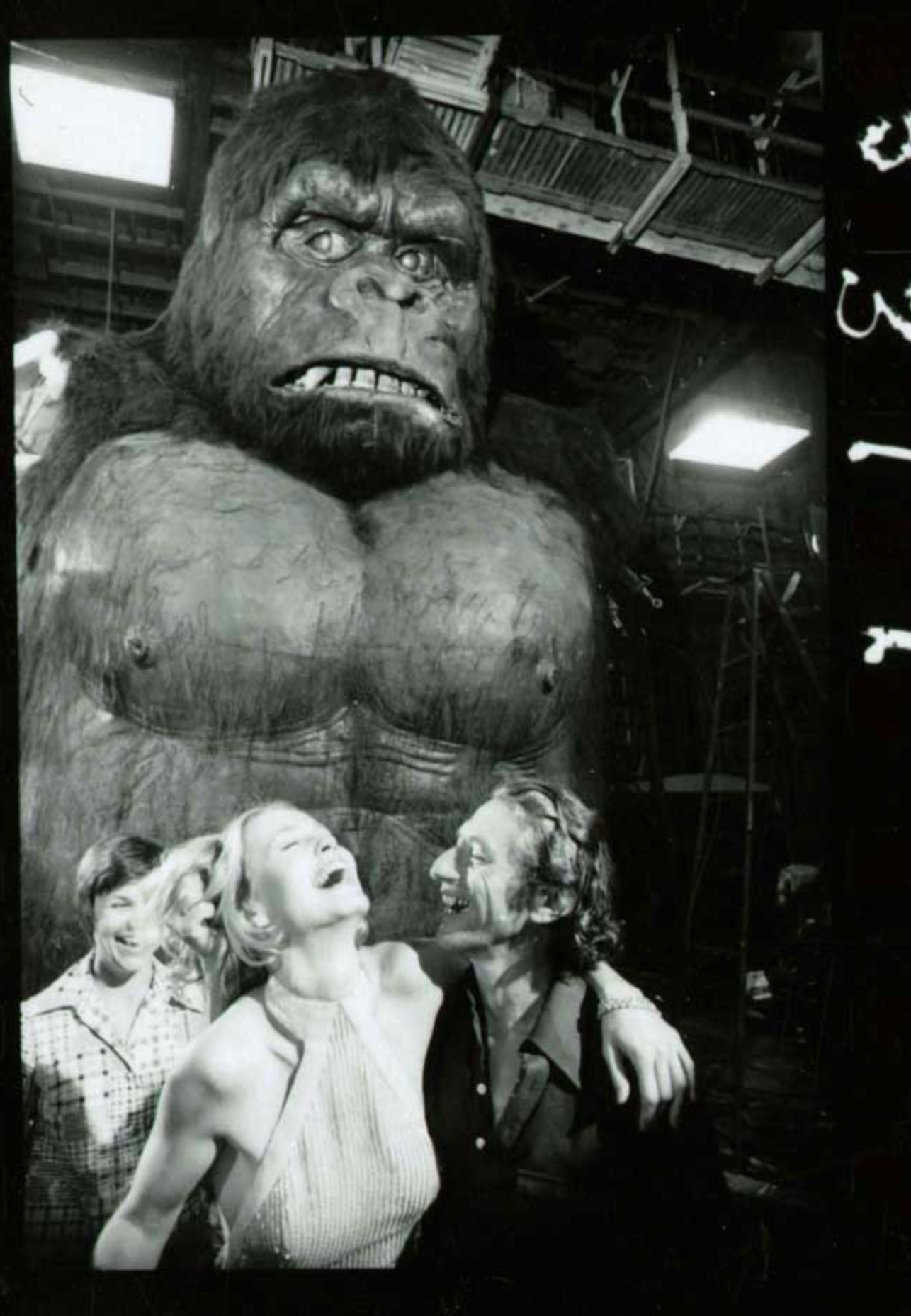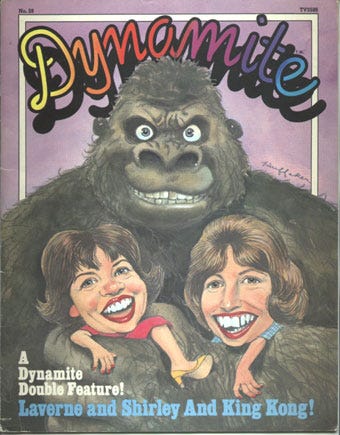
“Today’s movies tend to have the smell of cost accounting,” Richard Schickel laments. But, after seeing an hour and a half of the ’76 KONG, Schickel reports: “The people who made it weren’t counting pennies and were clearly having fun. Their enthusiasm shines through.”
- TIME magazine Editor’s Note, October 25, 1976
I realize it’s not fair to dredge up a passage written in the hoopla-heat-of-the-moment, but I use the statement above to illustrate something many of us have either forgotten or just never realized: Dino De Laurentiis’s 1976 remake of King Kong—like it or hate it—was a BIG DEAL. Richard Schickel is and was no lightweight as a film critic, historian and author, and even he and TIME magazine were taken in.
Imagine how pumped up a wide-eyed eleven year-old like me was!
It is perhaps obligatory to open any discussion of the much-derided “Dino” remake of King Kong (ironic tag for a film without dinosaurs) with some manner of justification and/or rationalization. The purists out there will say (and, indeed, have said in response to my previous post) that De Laurentiis’s production simply doesn’t count, that it stands as a bloated 70’s-era abomination that has no business being discussed in the company of those who truly appreciate the magic and wonder of what was created back in 1933 at RKO.
Dwan? Petrox Explorer? Blech.
That’s not to say that there aren’t those who very much like the ’76 version of King Kong and are not afraid to stand up and be counted. Years ago, Jeffrey Blair Lotta’s Kingdom Kong site, for instance, eloquently and passionately made a case for the relevance of Kong ’76.
As for me, I’ve already shown my hand. Pre-promotion for the ‘76 King Kong engulfed me. How could any person under driving age who loved monsters and science fiction not be excited about the approach of a new King Kong movie? I remember standing utterly aghast in my fourth grade classroom at St. Mike’s looking at Kong’s terrifying face for the first time on the now-famous Berkey poster (as I unfolded it from my just-arrived copy of Scholastic’s Dynamite magazine). Today, in my basement next to the underused weight bench, I have a Pakistani Kong poster that features a four foot-high blow-up of that same face.
Let’s keep in mind the kinds of horror movies that were coming out in the mid-70s. All we had to choose from were either limp “thrillers” that implied the presence of a good monster but never delivered or flicks that no sane parent would let their child see (The Texas Chainsaw Massacre, The Hills Have Eyes, The Exorcist, etc.). Outside of The Night Stalker on TV, (not to mention that creepy Movie of the Week starring Kim Darby called Don’t Be Afraid of the Dark), we kids were starved for full-on, scientifically-irrational monsters and giant beasts.
The Return of the King?
Suddenly, there’s an Italian man all over the TV talking about a giant ape.
Dino De Laurentiis says he’s gonna bring King Kong into the modern age and send him on a rampage in full color. What could be better? (Well, the 30s-era remake that Universal planned might have been, but that’s a different story…).
Suddenly, King Kong was everywhere. In the months leading up to the December 1976 release, you couldn’t swing an elasmasaurous without knocking over a Kong soft drink cup, Halloween costume, poster, or whiskey bottle. It was during that giddy pre-release period that George Turner’s The Making of King Kong book got into my prepubescent hands.
And there was a robot. Dino claimed his Kong would be a 40-foot mechanical monster that could stride down Broadway.
The media ate this up. “But what’s most extraordinary is that he’s fully functional,” Saga magazine reported breathlessly. “Kong’s arms move in 16 different positions. He walks and turns at the waist. His eyes and mouth move. And all it took to build and operate the little fellah was $1.7 million and a team of 20 crack technicians simultaneously operating hair-trigger levers.”
I remember seeing ads for Dino’s Kong on TV, hushing the room when they appeared. There was one particularly good one where you see Kong bursting through the Wall on Skull Island; “That’s a robot!” I’d exclaim. “Can you believe it?”
Even then, I didn’t believe it. But I wanted to, and it seemed everyone else did as well. And, young as I was, I still recognized the downright goofiness of the following onscreen credit:
The production wishes to acknowledge that King Kong has been designed and engineered by Carlo Rambaldi, constructed by Carlo Rambaldi and Glen Robinson, with special contributions by Rick Baker.
“Special contributions”? Like Mr. Baker was bringing them donuts or something?
The Kong Con
The “robot Kong,” it turns out, was a particularly shrewd move by De Laurentiis that had nothing to do with movie magic and everything to do with showmanship. In hindsight, we realize that there were two basic reasons for mecha-Kong’s existence:
Crush the competition: Two studios wanted to do KONG remakes for 1976. Universal announced a 30’s-era piece that would employ stop-motion animation, and Paramount hitched their wagon to De Laurentiis’s modern retelling. Both studios proceeded with preproduction while the case went to court. Meanwhile, Dino began talking about his robot, and Universal began to see the writing on the wall even before a judge ruled—De Laurentiis had captured the public’s attention with his robot tales, and anything so “mundane” as stop-motion was anticlimactic.
If you build it, they will fund: Much of De Laurentiis’s financing for KING KONG came from foreign pre-sales of the film—fueled by incessant (and, frankly, downright fraudulent) claims of how amazing his giant mechanical Kong would be.
In the final film, of course, Robo-Kong has basically one appearance and one move—bend wrist, open hand, drop cage fragment. Yet that hydraulic novelty essentially got Paramount’s KONG made and Universal’s version deferred until nearly thirty years later.
But none of that hindered the enthusiasm of eleven year-old me. I saw the movie three times in its opening week, and then saw it again when it came back a few months later for a return engagement. And all along the way I was amassing King Kong Colorforms, posters, magazines, trading cards, painting sets, puzzles, etc. Famous Monsters of Filmland featured Kong—old and new—in what seemed like every issue. You could get a Slurpee in a Kong plastic cup at 7-Eleven!
Surrounded by inspiration, I began scratching out my own “novelization” of the original KING KONG—I still hadn’t actually seen the ’33 film—in a small loose-leaf binder. I knew the basic plot, and I vividly remember being baffled by the conundrum of how to get the giant beast off of Skull Island and back to New York (I wasn’t yet aware of the original KONG screenwriter’s simple approach: “CUT TO NEW YORK, EXTERIOR”). The binder I puzzled over for so many hours is long gone, but my fascination with the process of communicating via words and pictures started then and there.
King Kong: Ferocious last-of-his kind enigma. Revered god-beast of Skull Island. Film icon. Guidance counselor.
And any movie that introduced us to Jessica Lange can’t be all bad, right?






Love the flashback perspective to '76. Happy Holidays , sir! Catch up soon